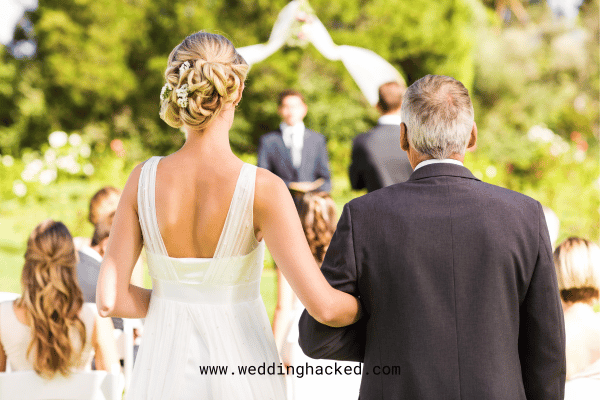Wedding Ceremony Timeline: How Long Do Wedding Ceremonies Last?

When it comes to wedding planning, figuring out the length of your wedding ceremony is one of those essential details that shapes the rest of your wedding day timeline. Couples often focus on the wedding reception, but the ceremony is where it all begins. It’s the moment you commit to your shared love story in front of your closest friends and family members. Knowing how much ceremony time you’ll need helps everything else fall into place. In this guide, we’ll break down the parts of the ceremony, explain what influences the length of a wedding ceremony, and help you find that sweet spot between meaningful and well-paced.
Read More: 48 Traditional Wedding Vows Examples To Make Everyone Cry
What’s the Average Length of a Wedding Ceremony?

The average wedding ceremony lasts between 20–30 minutes, though this can vary significantly based on the type of ceremony, number of wedding ceremony elements, and whether you’re including religious aspects or personal vows.
Here’s a quick look at typical timing:
Shorter ceremonies (15–20 minutes):
Often non-religious ceremonies or elopements with fewer readings and a simple ring exchange.
Standard ceremonies (20–30 minutes):
A balanced timeline with an officiant speech, personal touch, and perhaps one or two special readings.
Longer ceremonies (30–60 minutes or more):
Typically include religious traditions, cultural elements, or unity rituals like a sand ceremony
The right length depends on your couple’s preferences, traditions, and guest experience. A good rule of thumb is to ensure you have plenty of time for the most important elements, without dragging things out.
Wedding Ceremony Structure & Timing Breakdown

Here’s a breakdown of a typical marriage ceremony, with ceremony timing estimates to help you build your wedding day timeline:
1. Guest Arrival & Seating (10–15 minutes)
While not officially part of the ceremony, guests typically arrive early, especially if there’s travel time involved. This also gives the wedding photographer time to capture candids, decor, and the grand entrance.
2. Entrance of the Wedding Party (5–7 minutes)
This includes the bridal party, flower girl, best man, maid of honor, and of course, the married couple. Choose a song that fits the moment, and allow for some extra minutes if you have a larger number of guests or venue with a long aisle.
3. Opening Remarks by the Officiant (2–3 minutes)
This is when your officiant welcomes everyone, shares the couple’s love story, and outlines the order of events. It sets the tone and introduces the ceremony with warmth.
4. Readings or Music (5–7 minutes)
This can include poems, scripture, or even songs performed by close friends or family members. Additional readings can add depth, but be mindful of timing.
5. Exchange of Vows (5–7 minutes)
Whether you’re reciting own vows or using traditional ones, this is the emotional heart of the ceremony. Many couples choose to write personal vows, giving the moment a more intimate, genuine feel. This is also a great way to reflect your personality as a couple.
6. Ring Exchange (2–3 minutes)
A symbolic moment where you present your wedding rings, usually accompanied by a short script or repeat-after-me style promises.
7. Unity Ceremony or Cultural Traditions (5–10 minutes)
Unity candles, sand ceremonies, or handfasting rituals are a beautiful way to symbolize two lives becoming one. You may also incorporate cultural traditions or religious traditions from different denominations if you’re blending backgrounds.
8. Pronouncement & First Kiss (1 minute)
The officiant declares you married, and you seal it with your first kiss. This is always a favorite moment for guests—and photographers.
9. Recessional (3–5 minutes)
As music plays, the married couple exits the ceremony space followed by the wedding party. This transitions beautifully into family photos, the cocktail hour, and the rest of the celebration.
Read More: Complete Officiant Speech Template For A Wedding In 2025
What Affects the Length of the Ceremony?

Several factors can influence the length of the ceremony, including:
- Type of ceremony: A Catholic wedding ceremony with full Mass can last 45–60 minutes, while a civil ceremony might be 15–20 minutes.
- Personal preferences: Some couples include personal vows, others prefer to keep it simple.
- Number of people involved: A large guest list or bridal party can lengthen both the processional and recessional.
- Cultural traditions: These often add richness and time to the ceremony.
- Additional elements: Including live music, extra readings, or multiple rituals will extend the timeline.
- Wedding vendors: Your wedding planner, wedding coordinator, or event planners can help fine-tune the flow and prevent delays.
Read More: 12 Important Parts Of A Wedding Ceremony You Should Know About
Coordinating Ceremony Timing with the Wedding Timeline
Getting the ceremony time right ensures the rest of the day flows effortlessly- from cocktail hour to cake cutting and the first dance. Talk to your wedding planner or coordinator about the full wedding day timeline, including formal photos and vendor setup. Make sure you leave ample time between events so guests never feel rushed. If you’re having a first look, you may need to shift ceremony start time slightly. And lastly, ask your makeup artists, photographer, and other wedding vendors what time they need you ready.
Concluding Thoughts: There’s no one-size-fits-all answer. The perfect length depends on the personal preferences of the couple, any religious ceremony or cultural traditions included, and how you want the day to feel. Short or long, traditional or modern, your ceremony should be a reflection of who you are together. Whether it’s a 20–30 minute script or a longer ceremony rich in religious traditions, make sure it allows enough time for the emotions, the promises, and the joy of the moment.






